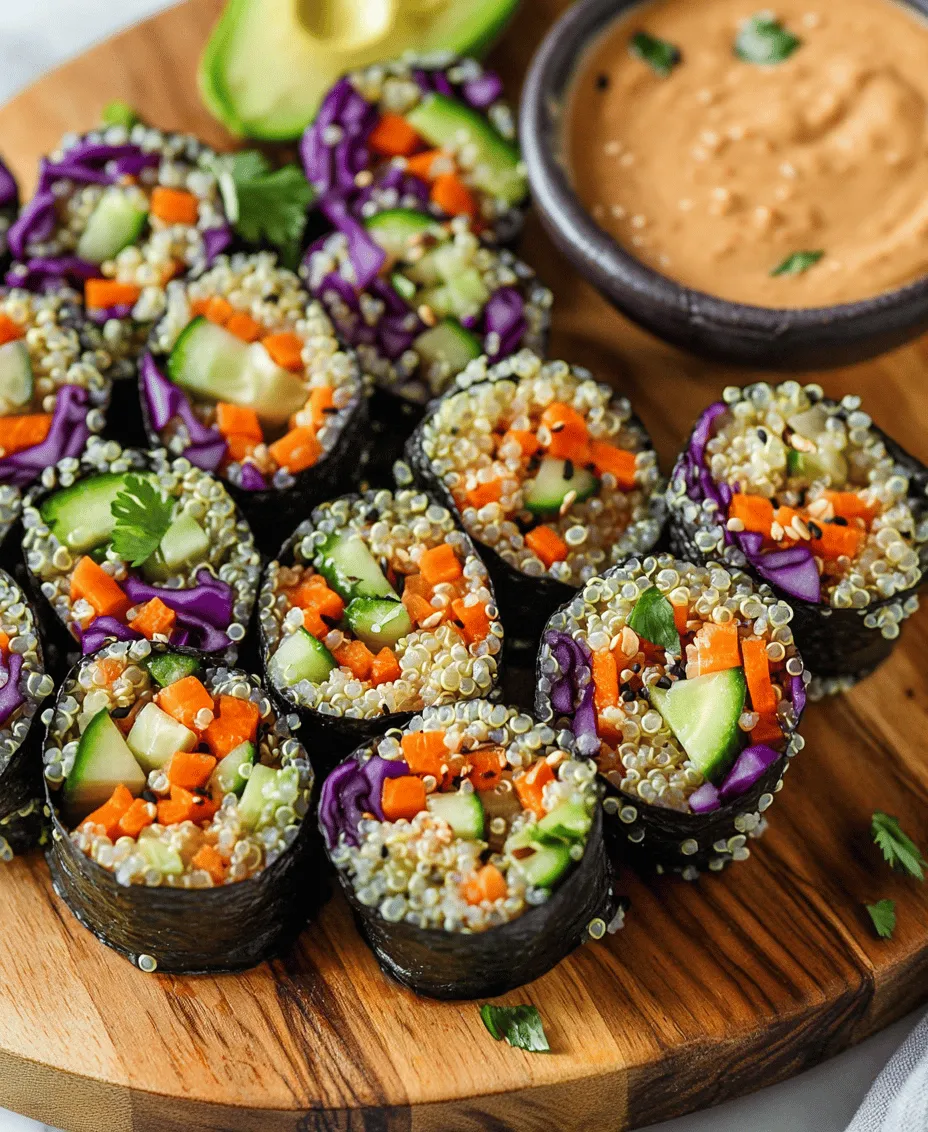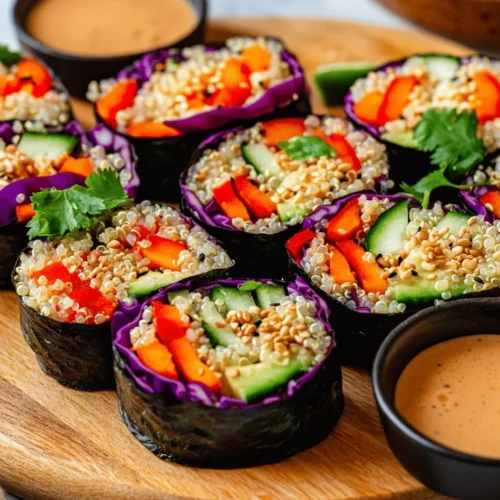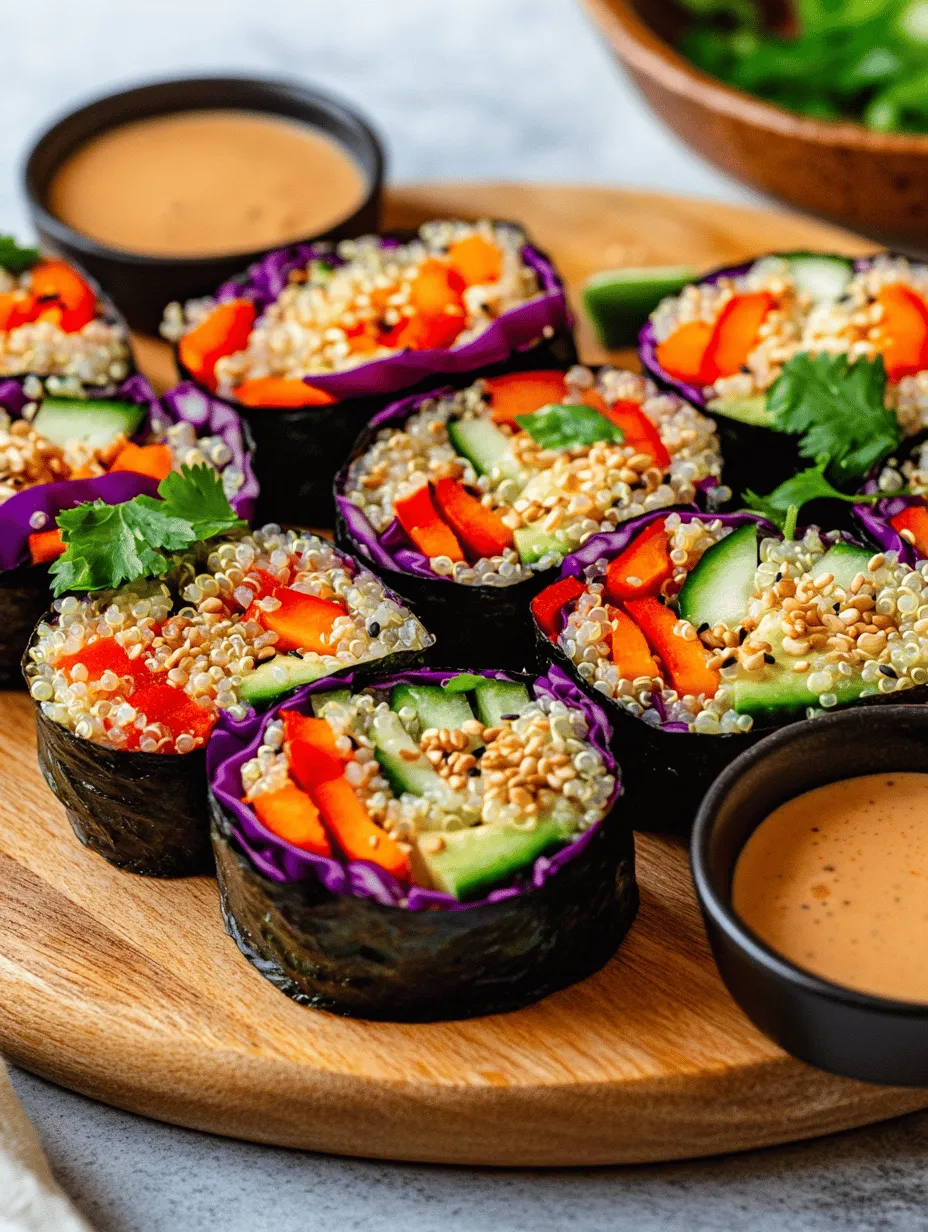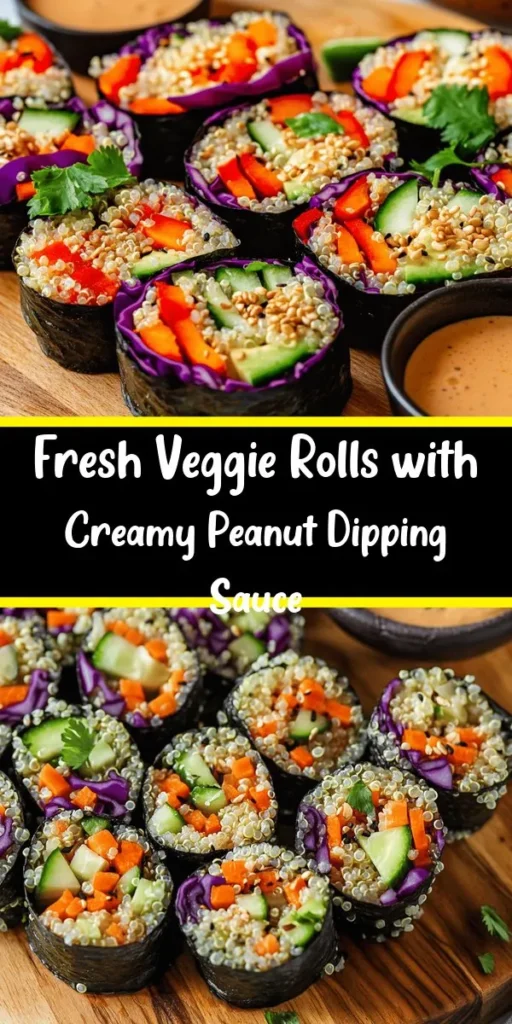Introduction
In recent years, the popularity of plant-based diets has surged, with more people recognizing the benefits of incorporating fruits, vegetables, and whole grains into their meals. From health-conscious individuals to environmentally-aware eaters, plant-based options are gaining traction across a wide spectrum of consumers. One delicious and vibrant way to embrace this trend is through making hearty veggie rolls with peanut sauce. These rolls are not only visually appealing but are also packed with nutrients that support overall health and wellness.
Hearty veggie rolls are a delightful combination of fresh vegetables, protein-rich quinoa, and a creamy, homemade peanut sauce. They make for a perfect lunch, snack, or appetizer, offering a satisfying crunch and a burst of flavors in every bite. The ingredients used in this recipe are not just tasty; they are also incredibly nutritious. Quinoa serves as a complete protein source, while fresh vegetables like carrots, red bell pepper, cucumber, and red cabbage add an array of vitamins, minerals, and antioxidants. The accompanying peanut sauce not only elevates the dish with its rich, nutty flavor but also contributes beneficial nutrients such as healthy fats and protein.
In this article, we aim to provide a comprehensive guide to crafting your own hearty veggie rolls with peanut sauce. From preparation to cooking tips and nutritional insights, we will walk you through every step needed to create these mouthwatering rolls in your kitchen.
Understanding the Ingredients
To create the perfect hearty veggie rolls, it’s essential to understand the primary ingredients that contribute to both their flavor and nutritional profile. Let’s delve into each component and discover why they are crucial for this recipe.
Quinoa
Quinoa is a star ingredient in these veggie rolls and serves as an excellent base. This ancient grain is renowned for its impressive nutritional profile. Unlike many grains, quinoa is a complete protein, meaning it contains all nine essential amino acids that our bodies cannot produce on their own. Additionally, quinoa is high in fiber, magnesium, B vitamins, iron, potassium, calcium, and antioxidants. These nutrients play vital roles in maintaining healthy bodily functions, from supporting muscle health to promoting heart health.
Not only is quinoa nutritious, but it is also gluten-free, making it an ideal choice for those with gluten sensitivities. Its slightly nutty flavor and fluffy texture when cooked provide a wonderful contrast to the fresh vegetables in the rolls.
Fresh Vegetables
The vibrant medley of fresh vegetables used in hearty veggie rolls not only provides a colorful presentation but also enhances the health benefits of the dish. Each vegetable brings its own unique set of nutrients:
– Carrots: Rich in beta-carotene, carrots are excellent for eye health and are also a great source of fiber, vitamin K1, and potassium. Their natural sweetness adds a delightful crunch to the rolls.
– Red Bell Pepper: Packed with vitamin C, red bell peppers are known for their immune-boosting properties. They also contain antioxidants that help combat oxidative stress in the body.
– Cucumber: With high water content, cucumbers are refreshing and hydrating. They are low in calories and provide small amounts of vitamin K, making them a great addition to any healthy dish.
– Red Cabbage: This colorful vegetable is known for its high antioxidant content, particularly anthocyanins, which are linked to various health benefits, including reduced inflammation. Red cabbage also contributes fiber and vitamin C.
Incorporating a variety of vegetables not only enhances the taste and texture of the rolls but also ensures a well-rounded nutrient intake that supports overall health.
Fresh Herbs and Avocado
Fresh herbs like cilantro and avocado play a crucial role in elevating the flavor profile of these veggie rolls. Cilantro adds a zesty, fresh taste that complements the other ingredients beautifully. It is also known for its detoxifying properties and may aid in digestion.
Avocado, on the other hand, contributes creaminess and healthy fats to the dish. Rich in monounsaturated fats, avocados support heart health and provide essential nutrients such as potassium and vitamins E and C. The combination of herbs and avocado in your veggie rolls not only enhances flavor but also boosts the nutritional value of your meal.
Importance of Fresh, High-Quality Ingredients
Using fresh, high-quality ingredients is paramount when preparing hearty veggie rolls. Fresh vegetables not only taste better but also retain more nutrients compared to those that have been stored for an extended period. When shopping for ingredients, opt for organic produce when possible, as this can further enhance the health benefits of your meal by reducing exposure to pesticides and chemicals.
Additionally, sourcing local ingredients can provide superior flavor and freshness. When everything is at its peak quality, you’ll find that your veggie rolls taste significantly better and are more satisfying to eat.
Making the Perfect Peanut Sauce
No veggie roll would be complete without a delicious peanut sauce to accompany it. This sauce not only adds flavor but also enhances the health benefits of the dish. Let’s explore what makes a great peanut sauce and how to prepare it.
Flavor Profile and Versatility
Peanut sauce is loved for its rich, nutty flavor and creamy texture. It pairs beautifully with fresh vegetables and grains, making it a versatile addition to many dishes beyond veggie rolls. The sauce can be used as a dip, dressing, or marinade, and it travels well, making it perfect for picnics or packed lunches.
Breakdown of Ingredients
The foundation of an exceptional peanut sauce lies in its ingredients. Here’s a closer look at what you’ll need to create a flavorful sauce that complements your veggie rolls:
– Natural Peanut Butter: Opt for natural peanut butter without added sugars or oils to enjoy the health benefits of peanuts. This type of peanut butter retains the natural oils and nutrients, providing a rich flavor and creamy consistency.
– Soy Sauce: Soy sauce adds depth and umami to the peanut sauce. For those following a gluten-free diet, tamari is a great alternative that offers similar flavor without gluten.
– Lime Juice: Fresh lime juice brightens the sauce and balances the richness of the peanut butter. It also provides a dose of vitamin C and enhances the overall flavor.
– Sweetener (Honey or Maple Syrup): A touch of sweetness is essential to round out the flavors of the sauce. Honey offers a natural sweetness, while maple syrup is a great vegan alternative.
– Garlic and Ginger: These aromatic ingredients add warmth and depth to the sauce. Both garlic and ginger come with their own health benefits, such as anti-inflammatory properties and digestive support.
Step-by-Step Instructions for Preparing Peanut Sauce
Creating peanut sauce is a straightforward process. Here’s how to make it:
1. Gather Your Ingredients: Ensure you have all the ingredients ready to go.
2. Mix the Base: In a bowl, combine 1/2 cup of natural peanut butter, 2 tablespoons of soy sauce (or tamari), and the juice of one lime.
3. Add Sweetness: Stir in 1 tablespoon of honey or maple syrup, adjusting to taste.
4. Incorporate Aromatics: Mince one clove of garlic and a small piece of fresh ginger (about 1 teaspoon). Add them to the bowl and mix well.
5. Adjust Consistency: If the sauce is too thick, add a tablespoon of water at a time until you reach your desired consistency.
6. Taste and Adjust: Sample your sauce and adjust the flavors as needed. You may want to add more lime juice for acidity, more sweetener for sweetness, or a dash of chili sauce for heat.
Tips for Achieving the Right Consistency
The consistency of your peanut sauce is crucial for achieving the perfect dip or drizzle. If you prefer a thinner sauce, gradually add water until you reach the desired texture. Conversely, for a thicker sauce, use less water or add more peanut butter.
Customizing the Sauce
One of the great things about peanut sauce is its versatility. Feel free to customize it to suit your palate. You can add a pinch of cayenne pepper for heat, incorporate sesame oil for a nutty flavor, or mix in some chopped peanuts for extra crunch. The possibilities are endless, allowing you to create a sauce that perfectly complements your hearty veggie rolls.
—
As we dive deeper into crafting these delightful veggie rolls, keep in mind the importance of preparation and quality ingredients. The combination of vibrant vegetables, protein-rich quinoa, and creamy peanut sauce promises a dish that is not only nourishing but also a feast for the senses. In the next part of this article, we will outline the step-by-step instructions for assembling your hearty veggie rolls, ensuring you create a meal that both looks and tastes amazing.

Preparing Your Rolling Station
Setting up an efficient rolling station is vital for a seamless experience when making hearty veggie rolls with peanut sauce. An organized workspace not only enhances your workflow but also makes the process more enjoyable. Here are the essential tools and equipment you will need:
1. Shallow Dish: This is crucial for softening the rice paper wrappers. Choose a dish that is wide enough to accommodate the wrappers fully submerged in water.
2. Kitchen Towel: A clean kitchen towel will help you manage moisture and keep your workspace tidy. You will use it to place the softened wrappers and keep them from sticking together.
3. Clean Workspace: Ensure your countertop or table is clean and free of clutter. A tidy space will allow you to move freely and focus on rolling your veggie rolls without distractions.
Organizing Your Ingredients
Before you start rolling, arrange your ingredients within easy reach. Group the fillings you plan to use, such as shredded carrots, cucumber slices, bell pepper strips, and fresh herbs like cilantro and mint. This organization will help streamline the assembly process and ensure you can access everything quickly as you work.
Assembling the Veggie Rolls
Assembling veggie rolls may seem daunting at first, but with the right technique, it becomes a simple and rewarding activity. Follow this detailed guide to ensure your rolls turn out perfectly every time.
Softening Rice Paper Wrappers
1. Fill a Shallow Dish with Warm Water: Use warm (not boiling) water, as it helps soften the rice paper without tearing.
2. Soak the Wrapper: Submerge one rice paper wrapper in the warm water for about 10-15 seconds, or until it becomes pliable but not overly soft. Watch closely; if you soak it for too long, it may become difficult to handle.
Filling and Rolling the Wrappers
1. Position the Wrapper: Once softened, lay the wrapper flat on your kitchen towel.
2. Add the Filling: Place a small amount of your chosen fillings in the center of the wrapper. A good rule of thumb is to use about 1/4 cup of filling. Avoid overfilling, as this can make rolling difficult and may lead to tearing.
3. Visual Cues for Filling: Aim for a mound of filling that is no wider than 2 inches across and about 2 inches from the edge of the wrapper. This will allow you to fold and roll without spilling.
4. Rolling Technique:
– Fold the Bottom: Start by folding the bottom edge of the wrapper over the filling.
– Fold the Sides: Next, fold in the left and right sides to encase the filling.
– Complete the Roll: Finally, roll the wrapper away from you, keeping it tight but not overly forceful to prevent tearing.
5. Tight Rolling: Ensure you are rolling tightly but gently. If you feel resistance, stop and adjust your grip. The wrapper should be snug around the filling without being stretched too thin.
Suggestions for Variations
Feel free to customize your veggie rolls based on personal taste or dietary requirements. Here are some ideas:
– Protein Additions: For extra protein, add sliced tofu, tempeh, or cooked chickpeas. These additions not only enhance the nutritional profile but also contribute to the overall texture and flavor.
– Flavor Twists: Incorporate different herbs or spices to diversify the flavor. Consider adding basil for a Thai twist or jalapeños for a spicy kick.
– Colorful Vegetables: Use a variety of colorful vegetables to make your rolls visually appealing. Think purple cabbage, yellow bell peppers, or even avocado for creaminess.
Serving Suggestions and Presentation
Once your veggie rolls are assembled, it’s time to think about presentation and serving. Here are some ideas to elevate your dish:
Plating for Visual Appeal
– Serve on a Platter: Arrange the rolls neatly on a large platter for a colorful display. You can cut them in half to showcase the vibrant fillings.
– Garnish: Add fresh herbs or edible flowers around the rolls for an elegant touch. A sprinkle of sesame seeds can also enhance both the look and flavor.
Serving Temperatures
– Chilled vs. Room Temperature: Veggie rolls can be enjoyed cold or at room temperature. If you prefer a refreshing sensation, refrigerate them for about 30 minutes before serving.
Pairing Suggestions
– Additional Dips: While peanut sauce is a fantastic choice, consider pairing the rolls with other dips like hoisin sauce, sweet chili sauce, or a tangy vinaigrette for added flavor.
– Complete Meal Experience: Serve your veggie rolls alongside a light salad or soup to create a complete meal. A tangy cucumber salad or a miso soup can complement the freshness of the rolls beautifully.
Nutritional Information and Health Benefits
These hearty veggie rolls with peanut sauce are not only delicious but also packed with nutrition. Here’s a breakdown of the health benefits:
Nutritional Breakdown
– Calories: Each roll contains approximately 80-100 calories, depending on the fillings used.
– Protein: If you add tofu or tempeh, the protein content can increase significantly, making it a satisfying meal option.
– Fiber: The fresh vegetables provide dietary fiber, promoting digestive health.
– Vitamins and Minerals: Ingredients like carrots, bell peppers, and leafy greens are rich in vitamins A, C, and K, contributing to overall wellness.
Health Benefits of a Plant-Based Diet
Adopting a plant-based diet, even part-time, has numerous health benefits. It is associated with lower risks of chronic diseases such as heart disease, diabetes, and certain cancers. The abundance of fruits, vegetables, and whole grains in your diet can lead to improved energy levels, better weight management, and enhanced mood.
Dietary Lifestyles
These veggie rolls cater to various dietary preferences, making them versatile for any occasion. They are:
– Vegan: Entirely plant-based and cruelty-free.
– Vegetarian: Suitable for those who consume dairy or eggs.
– Gluten-Free: Use gluten-free rice paper wrappers to accommodate gluten sensitivities.
Conclusion
Creating hearty veggie rolls with peanut sauce is a simple yet rewarding culinary experience. This recipe not only allows for creativity in the kitchen but also offers a nutritious meal option that fits seamlessly into various dietary lifestyles.
With the ease of assembly and the ability to customize fillings, these veggie rolls can become a staple in your meal rotation. Experiment with different combinations of vegetables, proteins, and sauces to find your perfect match.
Embrace the joy of crafting fresh, healthy meals at home and share your delicious creations with friends and family. Enjoy the satisfaction that comes from preparing wholesome food that nourishes both body and soul.



